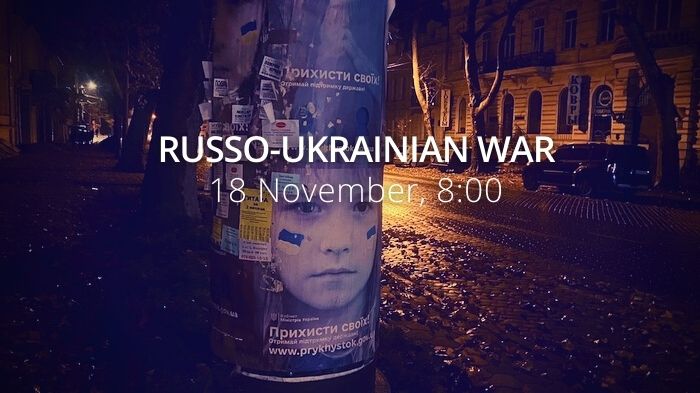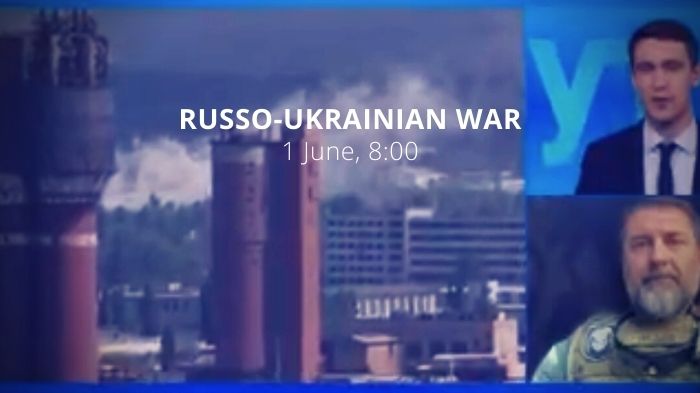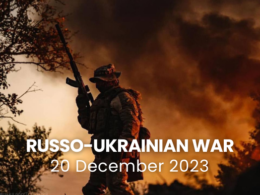Russian forces conducted another massive wave of missile strikes across Ukraine. Russian forces in eastern Kherson Oblast are likely partially vulnerable to a Ukrainian interdiction campaign such as the one Ukrainian forces successfully exploited to retake western Kherson Oblast. Ukrainian troops are conducting counteroffensive operations along the Svatove-Kreminna line. Russian forces continued ground attacks around Bakhmut, Avdiivka, and southwest of Donetsk City. Ukrainian troops continued targeting Russian military assets and concentration areas on the east bank of Kherson Oblast and in the rear areas of Zaporizhzhia Oblast. Belarus makes arrangements with Iran concerning the production of artillery shells, 2 Ukrainian nuclear power plants affected by Russian missile attacks. Russians place mines at the solar power plant in Kherson Oblast before retreating. Ukraine rights chief releases video of 'torture chamber' in liberated Kherson. Bodies of 991 civilians were discovered in territories liberated from Russian forces. Russian sources and proxy officials are flagrantly touting the forced adoption of Ukrainian children into Russian families. Dutch Court: "Girkin Found Guilty of Murder 298 Times." Finland Announces Largest Military Package for Ukraine. Norway contributes $30m to Nato’s assistance package for Ukraine. New Zealand Increases Military Aid to Ukraine. Czechia to train up to 4,000 Ukrainian troops. Spain offers to train 2,400 Ukrainian military personnel annually. Additional Canadian military aid to Ukraine announced.
Daily overview — Summary report, November 18
A map of the approximate situation on the ground in Ukraine as of 00:00 UTC 18/11/22.
There have been no notable changes to control since the last update. pic.twitter.com/jpfzCh2Ot1
— War Mapper (@War_Mapper) November 18, 2022
The General Staff’s operational update regarding the Russian invasion as of 06.00 am, November 18, 2022 is in the dropdown menu below:
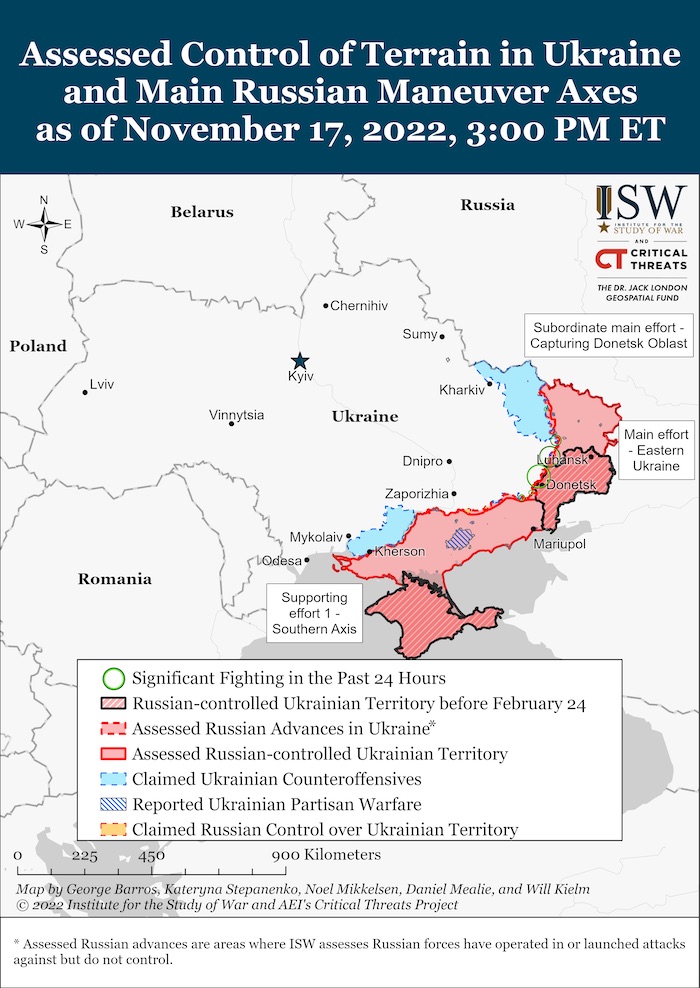
“Russian forces are concentrating their efforts on restraining the actions of the Defence Forces in certain directions and continue to equip defensive lines on the left bank of the Dnieper. At the same time, it conducts offensive operations in the Bakhmut, Avdiivka and Novopavlivka directions. Constantly conducts aerial reconnaissance.
Over the past 24 hours, units of the Defence Forces repelled the attacks of the occupiers in the areas of the settlements of Novoselivske and Stelmakhivka in the Luhansk oblast and Bilohorivka, Verkhnyokamianske, Spirne, Opytne, Pervomaiske, Vodyane and Novomykhailivka in the Donetsk oblast.
Russian forces do not stop shelling the positions of our troops and settlements near the contact line. Over the past day, the Russian invaders launched 5 airstrikes, 27 missile strikes and more than 50 MLRS attacks.
During the past 24 hours, civil infrastructure objects in Balakliya and Izium settlements of Kharkiv oblast were damaged by rocket attacks; Vilniansk, Zaporizhzhia oblast; Dnipro and Nikopol in Dnipropetrovsk oblast; Ochakiv, Mykolaiv oblast, and Odesa.
The situation in the Volyn and Polissya directions has not changed significantly. The threat of Russian forces launching missile and air strikes from the territory and airspace of the Republic of Belarus remains.
Russian forces shelled in other directions:
- in the Siversky direction - from mortars and artillery, in the areas of the settlements of Gremyach and Senkivka in the Chernihiv oblast and Hirky, Seredyna-Buda, Ukrainske and Fotovyzh in the Sumy oblast;
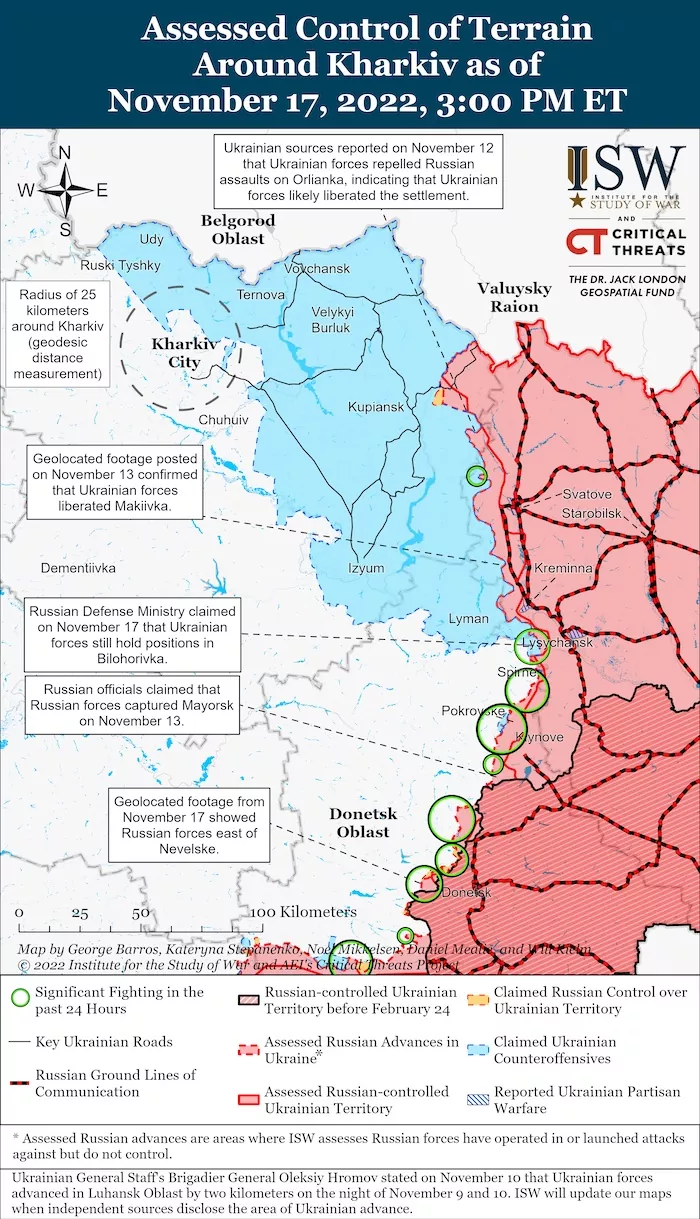
- in the Slobozhanskyi direction - from tanks and artillery of various types, in the areas of the settlements of Hlyboke, Ohirtseve, Osynove, Starytsa and Khatne of the Kharkiv oblast;
- in the Kupiansk and Lyman directions - from tanks and the entire spectrum of artillery, in the areas of the settlements of Berestove, Kislivka, Krokhmalne, Pishchane and Tabaivka in the Kharkiv oblast; Hrekivka, Makiivka, Nevske and Stelmakhivka in Luhansk oblast and Kolodyazne in Donetsk oblast;
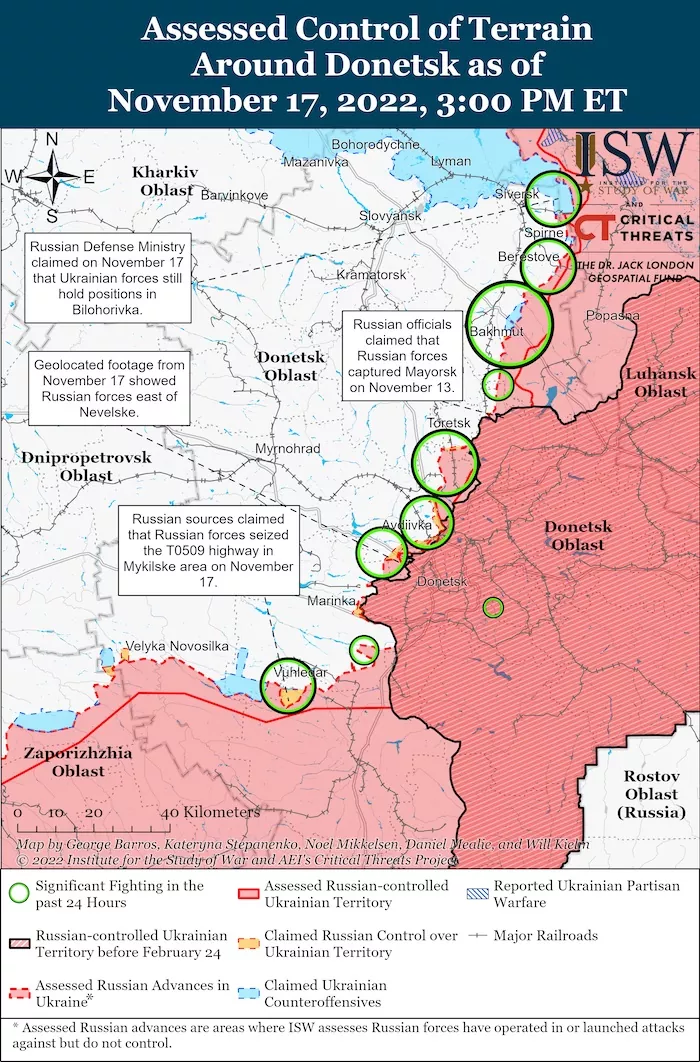
- in the Bakhmut direction - from tanks, mortars, artillery and MLRS, in the areas of Andriivka, Bakhmut, Bakhmutske, Bilohorivka, Verkhnyokamianske, Klishchiivka, Kurdyumivka, Ozaryanivka, Opytne, Mayorsk, New York, Soledar, Spirne and Yakovlivka Donetsk oblast;
- in the Avdiivka direction - from tanks and artillery, in the areas of Vodyane, Krasnohorivka, Mariinka, Novomykhailivka, and Pervomaiske settlements of the Donetsk oblast;
- in the Novopavlivka direction - from mortars, artillery and MLRS, in the areas of Bohoyavlenka, Vremivka and Vuhledar settlements of the Donetsk oblast;
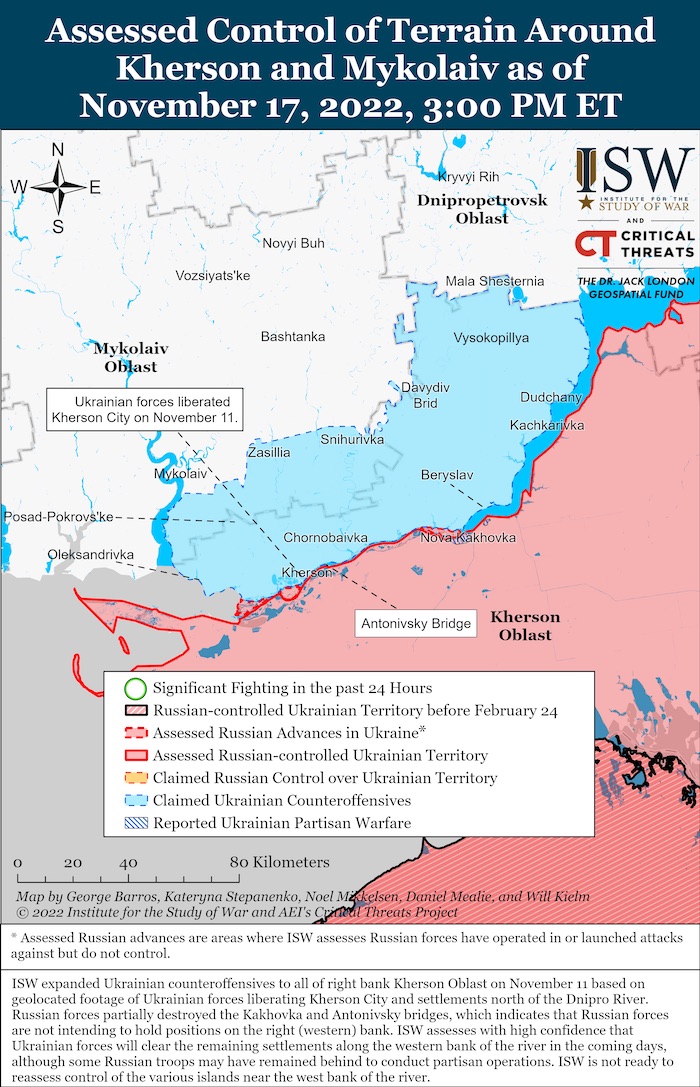
- in the Zaporizhzhia direction - from mortars, in the areas of Zaliznychne, Mali Shcherbaky and Shcherbaky of the Zaporizhzhia oblast;
- in the Kherson direction - from artillery and MLRS, in the areas of the settlements of Antonivka, Odradokamyanka and Chornobayivka in the Kherson oblast.
Active recruitment of workers from industrial enterprises to the private military company "Wagner" has begun in the Belgorod region. Thus, according to the agreement with the management of the Oskol electrometallurgical plant, workers of draft age will be involved in military training at the base of the "Wagner" PMC for a period of 30 days with retention of wages. Meetings are planned to be held in batches of 25% of employees of the specified category from the plant. Upon completion, participants will be asked to sign a contract with a private military company.
In connection with the significant losses of personnel and the insufficient number of medical personnel in the units of the occupiers on the territory of Ukraine, in the temporarily occupied territories of the Luhansk oblast, by order of the so-called ministry of health, employees of medical institutions in the region were obliged to register for military service for further additional staffing of vacant positions.
[A draft law is being prepared in the Russian Federation, which provides for the legalization of conscription for military service from the spring of 2023 for citizens of Ukraine who live in temporarily fixed and occupied territories and have received a passport of a citizen of the Russian Federation.]
[According to the available information, about 650 prisoners were recruited in the correctional facilities of the Russian Federation during the previous week. They were sent to the Rostov region for further training. Medical assistance for the specified category of persons, in case of injury, will be provided exclusively in medical facilities in the temporarily occupied territories of Ukraine.]
[In some settlements of the temporarily occupied territory of the Luhansk oblast, Russian forces intensified administrative and police measures. In particular, entrances to the village of Rubizhne from the directions of Kreminnaya and Varvarivka are closed. The movement of civilians in the city is restricted and filtering measures have been strengthened.]
[In Mariupol, the occupying authorities plan to deploy units of the Russian guard, special purpose and rapid response, with a total number of up to 400 people.]
[Russian occupying forces continue the forced evacuation of the population of Ukraine and the removal of property from the temporarily occupied territories of the Kherson oblast. In particular, on the night of November 16, the occupiers forcibly removed the population from Novokyivka. In addition, the central city hospital in Nova Kakhovka ceased to function because all medical equipment and ambulances were stolen and taken away in the direction of the temporarily occupied territory of the Crimean Autonomous Republic.]
Over the past day, the Defence Forces of Ukraine have shot down 4 cruise missiles, 2 guided air missiles and 5 Shahed-136 unmanned aerial vehicles.
During the current day, Ukrainian units of the missile forces and artillery hit 4 control points, 22 areas of concentration of manpower, weapons and military equipment, 6 ammunition warehouses and 4 other important objects of the occupiers.“
Military Updates
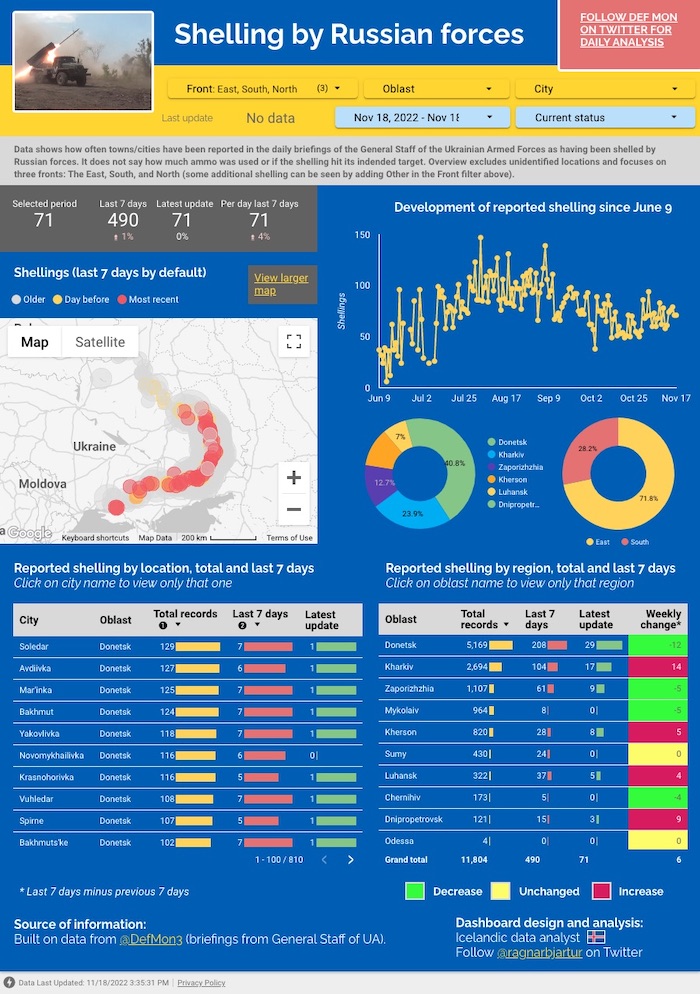
Situation update on the military situation on 17 November, by the Ukrainian General Staff. “Today (November 17) in the course of a massive air strike, Russian forces used 16 cruise missiles and five UAVs - said the Deputy Chief of the Main Operations Department of the Ukrainian General Staff, Brigadier General Oleksiy Gromov. Since November 11, Russian forces have launched 148 missile strikes, 111 of which were against critical infrastructure objects in Ukraine. It has used 26 kamikaze drones against the positions of our troops in the areas of five settlements and objects civil infrastructure. Only today, during the massive air strike, Russian forces used 16 cruise missiles and five unmanned aerial vehicles, said the brigadier general.
Russian forces continue their terror tactics against the civilian population, shelling civilian and energy infrastructure facilities of Ukrainian cities with rocket attacks.
In the course of the offensive operation, our troops crossed the line on the right bank of the Dnipro River, liberated up to 5,580 square kilometres of our territory and 198 settlements, — noted Gromov.
At the same time, the brigadier general reported that 102 air targets were destroyed during the reporting period by the forces and means of aviation, anti-aircraft missile forces and air defence of the Ground Forces and the Navy.
Last week, units of missile troops and artillery performed more than 1,200 fire missions, as a result of which damage was inflicted on 36 control points, 47 warehouses of ammunition and fuel and lubricants, as well as on other military objects of Russian forces.
The most difficult situation remains in the east of the country, where Russian forces are trying to cross the administrative border of the Donetsk region. Since last Friday, there have been more than 500 combat clashes in the region, he said. According to Gromov, in the east of the country, Russian forces continue to conduct offensive actions with missiles and airstrikes and carry out constant artillery fire on the positions of our troops along the entire line of contact.
In particular, in the Bakhmut direction, Russian forces carried out offensive actions to dislodge our units from occupied positions in the areas of populated areas: Belogorivka, Yakovlivka, Soledar, Bakhmutske, Bakhmut, Opytne, Klishchiivka, Andriivna, Kurdyumivka, Zelenopillia, Ozeryanivka, and Mayorsk.
In the Avdiivskyi and Novopavlivskyi directions, Russian forces carried out offensive actions in the area of settlements: Krasnohorivka, Vesele, Avdiivka, Opytne, Vodyane, Pervomaiske, Nevelske, Mariinka, Novomykhailivka, and Pavlivna. Russian forces carried out airstrikes in the area of 11 settlements.
Our servicemen reached the coast of the Dnipro River, which allows us to control the territory close to the temporarily occupied Crimean peninsula. Artillery soldiers and general servicemen of the Armed Forces of Ukraine are doing everything possible to hit Russian forces at the maximum range of our weapons, he said.
According to Gromov, Russian forces, after retreating from the right-bank part of the Kherson region, are rebuilding its troops and transferring combat-ready units to other directions. It is extremely important for Russian forces to establish control over the Donetsk region. We do not rule out that Russian forces may increase their efforts in the Zaporizhzhia and Luhansk directions as well. If we take his ambitious plans further, he may try to carry out offensive actions from the territory of Belarus through the Chernihiv and Sumy regions. But this is all in his plans, and it was already in our history. We fought back with dignity. At the moment, Russian forces are really shifting its troops in some directions, but we are also taking appropriate measures, Gromov emphasized.”
Luhansk Oblast: positive developments on Svatove-Kreminna axis, Ukrainian forces advance, Ukrainska Pravda reports, citing Serhii Haidai, the head of the Luhansk Oblast Military Administration. "The tendency is so far positive on the Svatove-Kreminna axis, our forces are advancing. Haidai added that liberating every metre of the Luhansk region requires great effort from the Armed Forces of Ukraine. He assumed that one of the reasons is the absence of a surprise factor, which the Ukrainian forces used to their advantage during the liberation of the Kharkiv Oblast.
After the liberation of the Kharkiv region, the Russian forces managed to mine a huge territory and deploy their reserves. They also deployed units of Kadyrovites [the Chechen forces led by Chechen leader Ramzan Kadyrov and fighting as part of the Russian army] and inmates recruited by Prigozhin [a Russian oligarch and close confidant of Russian President Vladimir Putin, and the founder of the Wagner Group private military company] and managed to blow up bridges and build some fortifications. So every metre of the Luhansk region and every settlement is being liberated with great effort, he added.”
Ukrainian relays supplied to Russia up to 2016 found in Iranian kamikaze drones - investigation
The Ukrainian state-owned factory's director confirmed that the company supplied its electric relays found in the Shahed-136 drones to Russia up to 2016.https://t.co/5pzgUfqKIh
— Euromaidan Press (@EuromaidanPress) November 17, 2022
Ukraine’s defence forces shoot down 4 missiles and 5 Shahed drones on Thursday – General Staff, Ukrainska Pravda reports. “Defence forces shot down two cruise missiles, two guided air-launched missiles, and five Shahed-136 kamikaze drones on Thursday, 17 November.”
Russians attack Ukrainian natural gas production facilities and PA Pivdenmash, Ukrainska Pravda reports. “Denys Shmyhal, the Prime Minister of Ukraine, has reported that Russia is carrying out strikes on Ukrainian natural gas production facilities and the Pivdennyi (Southern) Machine-Building Plant (PA Pivdenmash) in Dnipro.
Oleksii Chernyshov, Director of Naftogaz Ukraine [Ukraine’s state oil and gas production company], later reported that on Thursday, 17 November, Russian forces shelled a gas production facility in southern Ukraine, operated by UkrGasVydobuvannya [Ukraine’s largest state-owned gas producer]. As a result of these strikes, several facilities were destroyed and several more damaged.
The Pivdennyi (Southern) Machine-Building Plant in Dnipro is an enterprise that produces rocket and space equipment, as well as technology for defence, scientific and national economic purposes.”
According to British Defence Intelligence, (last 48 hours):
https://twitter.com/DefenceHQ/status/1593196005532450816
- Following the withdrawal of its forces from west of the Dnipro River, Russian forces continue to prioritise refitting, reorganisation and the preparation of defences across most sectors in Ukraine.
- Units have constructed new trench systems near the border of Crimea, as well as near the Siversky-Donets River between Donetsk and Luhansk Oblasts. Some of these locations are up to 60km behind the current front line, suggesting that Russian planners are making preparations in case of further major Ukrainian breakthroughs.
- It is likely that Russia will attempt to eventually redeployed some of the forces recovered from Kherson to reinforce and expand its offensive operations near the town of Bakhmut in Donetsk Oblast.
- Over the afternoon of 15 November, Russia carried out up to 80 long range missile strikes, mostly against power infrastructure targets across Ukraine. This is likely the largest number of strikes that Russia has conducted in a single day since the first week of the invasion.
- Munitions were launched from air, sea and land-based platforms. Although a large proportion of missiles were successfully intercepted. Ukraine is facing a significant decrease in the power available from its national grid. This will impact upon civilian access to communications, heating and water supplies.
- Continued strikes at this scale are drawing deeply upon Russia’s reserves of conventional cruise missiles, as degrading Ukrainian’s national infrastructure has become a key element of Russia’s strategic approach to the campaign.
Losses of the Russian army
As of Friday 18 November, the approximate losses of weapons and military equipment of the Russian Armed Forces from the beginning of the invasion to the present day:
- Personnel – about 83460 (+350),
- Tanks – 2879 (+1),
- Armoured combat vehicles – 5808 (+4),
- Artillery systems – 1865 (+5),
- Multiple rocket launchers –MLRS - 393 (+0),
- Air defence means – 209 (+0),
- Aircraft - 278 (+0),
- Helicopters - 261 (+0),
- Automotive technology and fuel tanks – 4366 (+4),
- Vessels/boats - 16 (+0),
- UAV operational and tactical level – 1536 (+5),
- Special equipment – 161 (+1),
- Mobile SRBM system – 4 (+0),
- Cruise missiles – 480 (+6)
Russian enemy suffered the greatest losses (of the last day) in the Lyman and Avdiivka directions.
Belarus makes arrangements with Iran concerning the production of artillery shells, Ukrainska Pravda reports, citing the Defence Intelligence of Ukraine (DIU). "The government of Belarus is seeking an opportunity to start production of 152mm and 122mm projectile components on its territory and maintain the closed manufacturing cycle in the future. It is also evaluating its capacity to organise the technological process of manufacturing reactive 122mm, 220mm and 300mm projectiles using imported components.
The Belarusian delegation is planning to visit Iran on 20-23 November, where it will hold talks about establishing the full production cycle of artillery shells.
Earlier, the National Resistance Center of Ukraine reported that Iran is supplying Russia with drones by sea and by air.“
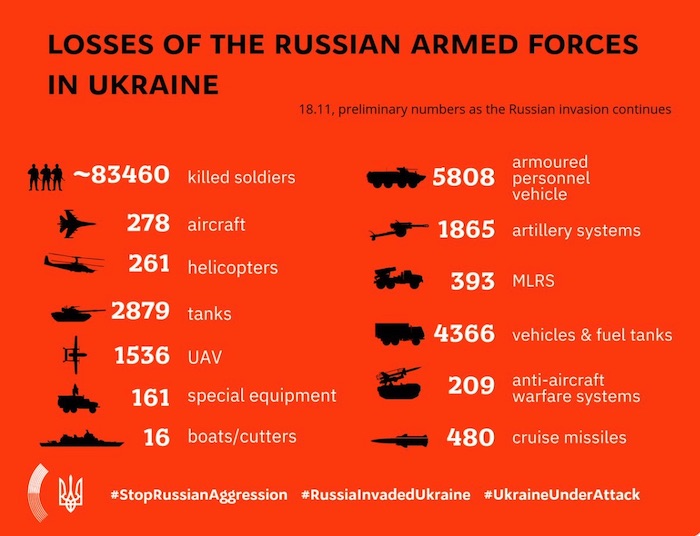
Humanitarian
Bodies of 991 civilians found in territories of Donetsk, Mykolayiv, Kharkiv, Kherson oblasts liberated from the Russian occupiers
"The police restored law and order in 577 settlements. 3,559 war crimes were documented," UA police rep said https://t.co/wPdXZn7HVp pic.twitter.com/IBFSpvy6fj
— Euromaidan Press (@EuromaidanPress) November 17, 2022
Zelensky: More than 10M Ukrainians remain without electricity, Ukrinform reports. “The elimination of the consequences of another missile attack against Ukraine continues all day... Again, there are emergency shutdowns in addition to planned, stabilization ones. Currently, more than 10 million Ukrainians are without electricity,” Zelensky said. According to him, most of them are in the Vinnytsia region, Odesa region, Sumy region and Kyiv.”
Ukrainians should brace for long blackouts that could last for days – DTEK, Ukrinform reports, citing Dmytro Sakharuk, DTEK CEO. "The situation is currently under control, albeit very difficult. The Russians have caused very serious damage to our transmission facilities, which are the substations transferring electricity from one region to another and through which many regions in the center and west get power. After one of our TPPs was hit, it halted operations due to damage," Sakharuk said.
According to the CEO, as of now, about 40% of consumers in Ukraine have no access to electricity. The company cannot predict when this share will decrease. Moreover, he added, it’s no longer about scheduled blackouts, but rather about scheduled, and very limited, supply of power in certain areas of the country. Sometimes power outages might last for a few days.
I’m talking days. Unfortunately, today we cannot talk about scheduled outages. In some areas, of which there are many, we have to talk about scheduled power supply. And the number of hours for which this scheduled supply may last could be very small – for two to three hours at most, said the DTEK chief.”
Millions of refugees from Ukraine have crossed borders into neighbouring countries, and many more have been forced to move inside the country. The escalation of conflict in Ukraine has caused civilian casualties and destruction of civilian infrastructure, forcing people to flee their homes seeking safety, protection and assistance the UNHCR reports. As of 15 November:
| Individual refugees from Ukraine recorded across Europe: | 7,841,359 |
| Hungary, Republic of Moldova, Poland, Romania, Slovakia | 2,330,200 |
| Russian Federation, Belarus | 2,868,019 |
| Other European countries | 2,634,140 |
| Refugees from Ukraine registered for Temporary Protection or similar national protection schemes in Europe: | 4,725,612 |
| Hungary, Poland, Romania, Slovakia | 2,321,658 |
| Other European countries | 2,403,954 |
| Border crossings from Ukraine (since 24 February 2022): | 15,354,147 |
| Border crossings to Ukraine (since 28 February 2022): | 7,747,450 |
Environment
https://twitter.com/EuromaidanPress/status/1593134684887998464
IAEA: 2 Ukrainian nuclear power plants affected by Russian missile attacks, Ukrainska Pravda reports, citing Rafael Mariano Grossi, Director General of the International Atomic Energy Agency (IAEA). "This was a very concerning development. It shows the potential nuclear safety and security risks facing all of Ukraine’s nuclear facilities during this terrible war, not just the Zaporizhzhia Nuclear Power Plant. While off-site power is now back at the Khmelnytskyi Nuclear Power Plant, yesterday’s power loss clearly demonstrates that the nuclear safety and security situation in Ukraine can suddenly take a turn for the worse, increasing the risk of a nuclear emergency.
Based on information received from the Ukrainian authorities, The IAEA has reported that the Khmelnytskyi NPP’s grid connection was completely lost due to military [Russian] attacks in its vicinity. This forced the power plant to temporarily rely on diesel generators for backup power. During this period, the plant’s two reactors were shut down, stopping their delivery of electricity to households, factories and other facilities. The plant only regained off-site power supply after a lapse of more than nine hours.”
Russians place mines at the solar power plant in Kherson Oblast before retreating, Ukrainska Pravda reports citing the press service of the National Police of Ukraine in Kherson Oblast. “Russian troops have placed mines on the premises of a solar power plant in Bilozerka hromada [an administrative unit designating a town, village or several villages and their adjacent territories - ed.] in Kherson Oblast while retreating from the right bank of the Dnipro River.
Law enforcement officers have pointed out that this solar power plant was a crucial element of the hromada’s energy security before the full-scale invasion.”
️Legal
https://twitter.com/EuromaidanPress/status/1593349004716347394
Ukraine rights chief releases video of 'torture chamber' in liberated Kherson, Reuters reports. “A top Ukrainian human rights investigator on Thursday released a video of what he said was a torture chamber used by Russian forces in the recently liberated Kherson region, including a small room in which he said up to 25 people were kept at a time.
Earlier on Thursday, according to Ukrainian media, Interior Minister Denys Monastyrsky said on national television that 63 bodies with signs of torture had been discovered by investigators in the Kherson region, adding that "we must understand that the search has only just started so many more dungeons and burial places will be uncovered".
Monastyrsky said law enforcement had uncovered 436 instances of war crimes during Russia's occupation of Kherson, which began shortly after the February invasion of Ukraine by Russian forces and ended last week. Eleven places of detention had been discovered, including four where torture had been practised, he said. Mass burial sites have been found in other parts previously occupied by Russian troops, including some with civilian bodies showing signs of torture.”
Russian sources and proxy officials are flagrantly touting the forced adoption of Ukrainian children into Russian families, ISW reports. “Prominent Russian milbloggers began circulating a multi-part documentary series on November 9 featuring several Ukrainian children from Donbas after being adopted into Russian families. The documentary series claims that Russian officials have evacuated over 150,000 children from Donbas in 2022 alone. […].
Head of the Chechen Republic Ramzan Kadyrov additionally stated he is working with Russian Federation Commissioner for Children’s Rights Maria Lvova-Belova to bring “difficult teenagers” from various Russian regions and occupied Donetsk and Luhansk Oblasts to Chechnya to engage in “preventative work” and “military-patriotic education.”
Lvova-Belova has continually advocated for deportations and adoptions of Ukrainian children and has herself adopted a child from Mariupol. Forced adoption programs and the deportation of children under the guise of vacation and rehabilitation schemes likely form the backbone of a massive Russian depopulation campaign that may amount to a violation of the Convention on the Prevention and Punishment of the Crime of Genocide and constitute a wider ethnic cleansing effort, as ISW has previously reported.”
Bodies of 991 civilians were discovered in territories liberated from Russian forces, Ukrainska Pravda reports, citing Oleksii Serhieiev, Head of the Department of Organisational and Analytical Support and Operative Response of the National Police of Ukraine. "Police officers carried out stabilisation measures and restored order in 577 settlements in the recently liberated territories of Donetsk, Mykolaiv, Kharkiv and Kherson oblasts. Fifteen police departments have resumed their work and 3,559 war crimes have been documented. The bodies of 991 civilians have been discovered.
Serhieiev added that explosives technicians from Ukraine’s National Police have recovered 33,000 explosive devices from the same territories.”
District Court of The Hague found Ihor Girkin & his subordinate fighters Serhii Dubinsky, Leonid Kharchenko guilty of shooting down MH17 & killing 298 ppl. Court sentenced them to life imprisonment. Before that, court confirmed Ukrainian version of causes https://t.co/0ROaRn1Omw
— Euromaidan Press (@EuromaidanPress) November 17, 2022
Dutch Court: "Girkin Found Guilty of Murder 298 Times", One Suspect Acquitted, European Pravda reports. The District Court of The Hague has found “guilty Russian nationals Igor Girkin and Sergey Dubinsky and Ukrainian Leonid Kharchenko [for downing MH17]. Before that, the court had confirmed the Ukrainian version of the MH17 disaster, noting, however, that the main target should have been Ukrainian military aircraft. […] Earlier, the Hague Court recognised that Russia controlled the "DNR" during the downing of the MH17 passenger jet.”
433 children were killed, 837 children injured
, 11,225 deported by foe forces, and 294 reported missing - the Office of the Prosecutor General of Ukraine reports as of November 18. 2,719 educational establishments are damaged as a result of shelling and bombings, and 332 of them are destroyed fully.
Support
https://twitter.com/EuromaidanPress/status/1593257923589070848
Finland Announces Largest Military Package for Ukraine, European Pravda reports. “Finland will hand over another package of defence materiel to Ukraine with the value of EUR 55.6 million. The decision was made by the President of Finland on November 17, 2022, at the suggestion of the government, reports the Ministry of Defence of Finland. […]
For operational reasons and to ensure that the delivery reaches its destination, more detailed information on the content of the assistance, manner of delivery or schedule will not be provided.”
Sweden to deliver its biggest military aid package yet to Ukraine, Reuters reported Wednesday. “Sweden will deliver new military aid worth 3 billion crowns ($287 million) to Ukraine, its biggest package of defence material to date which included an air defence system, Prime Minister Ulf Kristersson said.”
According to a statement by the Swedish Government, “the military support package is larger than all the eight previous military materiel support packages combined, and the humanitarian package is the largest sent to date. […]
The new military support package is expected to contain an advanced weapons system for air defence including advanced ammunition, and also advanced ammunition for additional air defence systems, light all-terrain vehicles, personal equipment including winter equipment and body protection, gun laying equipment, tents and camouflage netting.”
Norway contributes $30m to Nato’s assistance package for Ukraine, Army Technology reports. “The Norwegian Ministry of Defence (MoD) has announced a contribution of Nkr300m ($30m) to provide military equipment and training to the Ukrainian soldiers. The contribution has been made to the NATO-led Comprehensive Assistance Package (CAP).
Norwegian Defence Minister Bjørn Arild Gram said: “This grant will go to military equipment and training of Ukrainian forces, and will be channelled through international funding mechanisms such as Nato’s CAP and British-led International Fund for Ukraine. In addition, there are national initiatives such as the donation of necessary equipment and winter clothing.”
New Zealand Increases Military Aid to Ukraine, The Defense Post reports. “The New Zealand government has enhanced its defence commitments to Ukraine, boosting military equipment funding and extending training for Ukrainian warfighters. Prime Minister Jacina Ardern on Monday announced an undisclosed amount of additional military support to improve Ukraine’s self-defence […].
The government is also expanding its support for the British-led operation training for Ukrainian armed troops by sending an additional 66-person infantry training team until July 2023. At present, the New Zealand Defence Force (NZDF) has deployed a total of 135 soldiers to the United Kingdom and Europe.”
Czechia to train up to 4,000 Ukrainian troops, Ukrinform reports, citing Reuters. “The Czech government intends to train as many as 4,000 Ukrainian troops over the next year. “The training would be done in five four-week cycles with up to 800 troops attending each, and cost 975 million crowns ($41.60 million),” the Defense Ministry said. Ukraine has shown interest in the training of mainly mechanized battalions and medics, engineering and chemical troops, Cernochova said.
The Czech Republic will also send 55 troops as instructors or members of command structures of the planned EU training mission in other EU member states. As Ukrinform reported earlier, the European Union foreign ministers at a meeting in Luxembourg on Monday approved the launch of a training mission for 15,000 Ukrainian servicemen, and also agreed to provide an additional EUR 500 million to fund arms supplies to Ukraine.”
Spain offers to train 2,400 Ukrainian military personnel annually, Ukraine Business News reports. “Spain could train 2,400 Ukrainian servicemen per year as part of the recently approved EU mission with a total budget of €106.7M, stated the Minister of Defense of Spain, Margarita Robles. We are proposing to train a total of 400 soldiers every two months. Therefore, I would like to say that the capacity that we have is about 2,400 soldiers per year. That is the proposal, the total capacity that we have, Robles said.
To this end, the Spanish military academy in Toledo was adapted” so that Ukrainian soldiers could have appropriate living conditions” to carry out their training tasks. The minister noted that Spain is currently training a total of 112 Ukrainian servicemen.”
Minister Anand announces additional Canadian military aid to Ukraine at the Ukraine Defense Contact Group meeting, according to a press release by the Government of Canada. “Canada will provide approximately $34 million in additional military aid to Ukraine. Minister Anand also highlighted that Canada will extend its training mission in the United Kingdom under Operation UNIFIER until the end of 2023. This latest military aid package responds to urgent priorities identified by Ukraine, including:
- approximately $5 million to continue providing critical satellite imagery to the Armed Forces of Ukraine (AFU);
- more than $18 million for additional, high-resolution drone cameras; and,
- up to $10 million to provide additional winter gear to support the AFU, including portable heaters, thermal blankets and sleeping bags sourced from Canadian companies through the Canadian Commercial Corporation.
With winter setting in, Canadian industry has stepped up to help quickly meet the AFU’s critical need for winter gear. Following Minister Anand’s commitment to providing 500,000 items of winter gear and clothing at last month’s UDCG meeting in Brussels, contracts have been signed with 11 Canadian companies and deliveries are underway.”
“The West continues to support Ukraine’s bedrock right to defend itself,” Lloyd Austin says, Ukrainian World Congress reports. “US Secretary of Defense Lloyd Austin III and Chairman of the Joint Chiefs of Staff General Mark Milley held a news conference Wednesday in the wake of the seventh meeting of the Ukraine Defence Contact Group (so-called Rammstein 7), called by Austin “another highly successful session,” according to the US Department of Defense
. The key takeaways from the news conference in terms of the pledged Western military aid to Ukraine can be summarized as follows:
- Spain to send two more HAWK launchers and missiles;
- The United States has announced $400 million in additional commitments to support Ukraine, including missiles for the HAWK air defence systems – a complement to what Spain has committed. The $400 million package also includes other air defence systems, along with ground systems such as up-armoured Humvees, grenade launchers and additional HIMARS ammunition as well as lots of other pieces of equipment;
- UK. to train another 19,000 Ukrainian troops next year; […]
- Germany has advanced much-needed donations of air defence, artillery and MLRS ammunition;
- Greece announced an important donation of 155-millimetre ammunition;
- Poland has committed additional artillery and tank ammunition, as well as short-range air defence capabilities.
We were meeting today as Russia continues to target Ukraine’s civilians and bombard its energy grid, but Russia’s deliberate cruelty only deepens our resolve, and we’ll continue to support Ukraine’s bedrock right to defend itself and defend the rules-based international order, the Secretary of Defense said in his opening remarks. Ukraine’s troops continue to consolidate their gains on the battlefield as they head into the winter, and the contact group continues to push hard to bolster Ukraine’s air defences in the face of Russia’s ongoing barrages.
He also said he was pleased to report the very impressive performance of the NASAMS air defence systems that the United States sent to Ukraine are now operational. The NASAMS systems had a 100 percent success rate in intercepting Russian missiles, he said.
According to Gen. Mark Milley, the mission of the group is to “support Ukraine as they counter the illegal and unprovoked Russian aggression and to continue to supply Ukraine with the capabilities necessary to defend their sovereignty.”
This is a war of choice – it’s a war of choice for Russia. They embarked on a tremendous strategic mistake. They made a choice in February of this year to illegally invade a country that posed no threat to Russia. […] In short, they wanted to overrun all of Ukraine, and they lost. They didn’t achieve those objectives. They failed to achieve their strategic objectives and they are now failing to achieve their operational and tactical objectives, Milley said. He added that Russia started this war and can end it.”
New Developments
Hungary wants to strengthen economic ties with sanctioned Iran – Hungarian FM
Hungarian FM wrote on Facebook that Budapest allegedly wants "to normalize the situation in the Middle East." Iranian economy minister has already arrived in Hungary https://t.co/plghwDq4mY
— Euromaidan Press (@EuromaidanPress) November 17, 2022
- Kremlin admits it attacks Ukraine's infrastructure to force Zelenskyy to negotiate, Ukrainska Pravda reports, citing Dmitry Peskov, press secretary of the President of the Russian Federation. “Peskov stated that the missile strikes are aimed at Ukraine’s infrastructure facilities, which are supposedly "directly or indirectly related to its military potential". He said the lack of electricity and heating in many areas of Ukraine is the consequence of the actions of the Kyiv authorities in refusing to negotiate.”
- Only full protection of the Ukrainian sky will encourage Russia to end the war – President, Ukrinform “Only full protection of the Ukrainian sky will protect both Ukraine and Europe from possible escalations of Russian aggression and will definitely encourage the Russian Federation to end the war. President of Ukraine Volodymyr Zelensky said this in his video address.”
- EU says Russia is not yet ready for peace in Ukraine, Reuters “European Union foreign policy chief Josep Borrell said on Thursday that peace in Ukraine was not going to be possible until Russia withdrew its troops, but that Moscow showed no signs of being ready for that. I am afraid Russia is not ready to withdraw and as far as it doesn't withdraw, peace will not be possible, Borrell [said].”
- Russia is not considering using nuclear weapons - Kremlin says, Reuters “Russia is not considering using nuclear weapons, the Kremlin said on Thursday. President Vladimir Putin has said Russia will defend its territory with all available means, including its nuclear weapons, if attacked. Russian officials say the West has repeatedly misinterpreted Kremlin statements.”
Ukrainian experts will participate in investigation of the missile fall in Poland, Zelenskyy said
"I don't know exactly 100% what happened this time. We're thankful we're not blamed because we're fighting Russian missiles on our territory," he said https://t.co/dYVCo7uaaq pic.twitter.com/WEb8uXKQ8f
— Euromaidan Press (@EuromaidanPress) November 17, 2022
- "Emotions are understandable": Polish president comments on Zelenskyy's statement about the missiles that landed in Poland, Ukrainska Pravda reports, citing Polsat News. Andrzej Duda, President of Poland, has “stressed that the missile’s landing in Poland was an unfortunate and absolutely not a deliberate event. There is a war on the other side of the border, Russia has launched several hundred missiles at Ukraine, Ukraine was defending itself, and as a result of this, unfortunately, the thing that happened had happened. No one wanted to harm anyone in Poland, let alone kill anyone. This is just a tragedy, our shared tragedy in a certain sense, the biggest tragedy of those who had lost their loved ones – their parents and their husbands, the Polish president said.”
- UN nuclear watchdog board again urges Russia to end actions at Ukrainian plants, Reuters “The UN nuclear watchdog's 35-nation Board of Governors on Thursday passed its third resolution since the outbreak of war in Ukraine calling on Russia to end all actions at Ukrainian nuclear facilities, diplomats at the closed-door vote said. The text submitted by Canada and Finland and seen by Reuters also specifically said the International Atomic Energy Agency (IAEA) called on Russia to immediately withdraw from the Zaporizhzhia nuclear power plant in southern Ukraine.”
- Black Sea grain export deal extended, but Russia wants more on fertiliser exports, Reuters “A deal aimed at easing global food shortages by helping Ukraine export its agricultural products from Black Sea ports was extended for four months on Thursday, though Russia said its own demands were yet to be fully addressed. Russia's foreign ministry confirmed the extension of the deal for 120 days starting from Nov. 18, without any changes to the current one.”
Assessment
- On the war.
The Institute for the Study of War has made the following assessment as of 17 November 2022:
Eastern Ukraine: (Eastern Kharkiv Oblast-Western Luhansk Oblast)
Russian sources claimed that Ukrainian forces continued counteroffensive operations in the directions of Svatove and Kreminna on November 17. The Russian Ministry of Defense (MoD) claimed that Russian air and artillery strikes prevented Ukrainian forces from attacking in the direction of Novoselivske and Kolomychikha (both within 15km northwest of Svatove); near Makiivka, Ploshchanka, and Chervonopopivka (all within 22km northwest of Kreminna); and near Dibrova (5km southwest of Kreminna). The Ukrainian General Staff reported on November 17 that Ukrainian forces also repelled Russian assaults within 16km northwest of Svatove near Stelmakhivka and south of Kreminna near Bilohorivka. Russian mibloggers claimed that Ukrainian forces tried to attack Russian defenses near Svatove and conducted offensive operations near Kuzemivka (13km northwest of Svatove) on November 16. A milblogger cited a BARS-13 (Russian Combat Reserve) commander who claimed that Ukrainian forces are preparing for a large offensive along the Orlianka-Zatizhne-Svatove line, although ISW offers no assessments about future Ukrainian operations.
The BARS-13 commander also claimed that Ukrainian forces tested Russian defenses near Kreminna on November 16 and that Ukrainian operations south of Kreminna have created another active sector of the Ukrainian counteroffensive in Luhansk Oblast. Another BARS-13 source claimed that fighting is ongoing 12km south of Kreminna in Bilohorivka, Luhansk Oblast as of November 16. Russian sources also claimed that Ukrainian forces struck Myrne, Zymohiria, Starobilsk, Svatove, Biloukrakyne, and Kadiivka in Luhansk Oblast with HIMARS rockets. Ukrainian forces will likely continue to target Russian military concentrations and logistics in Luhansk Oblast as the eastern Ukrainian counteroffensive progresses.
Russian forces conducted another massive wave of missile strikes across Ukraine on November 17. The Ukrainian General Staff reported that Russian troops launched five airstrikes and 25 cruise missile strikes at civilian infrastructure objects in Dnipropetrovsk, Odesa, Kharkiv, Zaporizhzhia, Dnipropetrovsk, and Mykolaiv oblasts throughout the day. Ukrainian Air Force Command noted that Ukrainian air defense forces destroyed four cruise missiles, five Shahed-136 drones, and two Kh-59 guided missiles. Russian forces conducted the largest missile attack since the start of the war on November 15, and as ISW has previously assessed, such missile campaigns are consuming Russia’s already depleted store of precision munitions.
Russian forces in eastern Kherson Oblast are likely partially vulnerable to a Ukrainian interdiction campaign such as the one Ukrainian forces successfully exploited to retake western Kherson Oblast. Several major ground lines of communication (GLOCs) run through eastern Kherson Oblast into other Russian-controlled areas in southern Ukraine: the southern T2202 Nova Kahkovka-Armiansk route, the southeastern P47 Kakovkha-Henichesk route, and the M14 highway that runs eastward into Melitopol, Berdiansk, and Mariupol. Geolocated satellite imagery indicates that Russian troops are establishing defensive positions along some of these critical GLOCs, and social media reporting indicates that Ukrainian strikes have already begun targeting Russian concentration areas and military assets on these routes. The limited number of high-quality roads and railways in this area, particularly connecting Crimea to the mainland, creates potential bottlenecks that could be vulnerable to Ukrainian interdiction efforts that would gradually degrade the Russian ability to continue supplying its grouping in eastern Kherson Oblast and other areas of southern Ukraine. ISW previously reported the targeting of similar bottlenecks along key GLOCS--not just the bridges across the Dnipro River--during Ukraine’s Kherson counteroffensive in late August to mid-October culminated in the Russian withdrawal from the west bank of Kherson Oblast to positions further south of the Dnipro River. Ukrainian forces will likely find it harder to achieve such dramatic effects in eastern Kherson but may be able to disrupt Russian efforts to solidify and hold their new defensive lines.
Russian President Vladimir Putin signed a decree changing the composition of the Russian Presidential Council for Civil Society and Human Rights (HRC) on November 17. The decree notably expels four Russian human rights activists, including Ekaterina Vinokurova, who wrote a piece criticizing the rise of “patriotic” Telegram channels and nationalist milbloggers who have cornered the information space against opposition outlets who deviate from the predominant Kremlin line of the war in Ukraine. Russian media previously reported that Vinokurova and other members of the HRC appealed to the Russian Investigative Committee to look into the widely circulated video of the execution of a former Wagner Group fighter who reportedly defected to Ukraine. Putin’s new appointees to the HRC include a slate of Russian political and proxy members and notably Sasha Kots, a prominent milblogger and war correspondent who has been heavily involved in covering Russian operations in Ukraine. Kots most recently called for Russia to maintain massive missile strikes against critical Ukrainian infrastructure on November 17. This decree likely represents the Kremlin’s wider effort to stifle domestic civil opposition by continuing to platform prominent voices in the information space that propagate the Kremlin’s line on the war in Ukraine.
Key Takeaways
- Russian forces conducted another massive wave of missile strikes across Ukraine on November 17
- Russian forces in eastern Kherson Oblast are likely partially vulnerable to a Ukrainian interdiction campaign such as the one Ukrainian forces successfully exploited to retake western Kherson Oblast.
- Russian President Vladimir Putin signed a decree changing the composition of the Russian Presidential Council for Civil Society and Human Rights (HRC) on November 17.
- Russian sources continued to claim that Ukrainian troops are conducting counteroffensive operations along the Svatove-Kreminna line.
- Russian forces continued ground attacks around Bakhmut, Avdiivka, and southwest of Donetsk City.
- Ukrainian troops continued targeting Russian military assets and concentration areas on the east bank of Kherson Oblast and in the rear areas of Zaporizhzhia Oblast on November 17.
- Russian authorities continue to face discontented mobilized personnel and low morale on the front lines.
Russian occupation officials continued to destroy Ukrainian culture in Russian-occupied territories.“
Ukraine holds nuclear strike preparedness drills, Ukrainska Pravda reports, citing Pavlo Kyrylenko, Head of the Donetsk Oblast Military Administration. "Actions that will have to be taken in the event of a nuclear strike on Donetsk Oblast were rehearsed today during an online drill. The drill was based on a scenario in which Russia has deployed tactical nuclear weapons against an infrastructure facility in [Donetsk] Oblast.
Kyrylenko said that all relevant departments of the Donetsk Oblast Military Administration and local administrations, emergency responders, police officers and medical staff took part in the drill.
The goal of the exercise was to ensure that all personnel involved would know how to act in the event of a tactical nuclear strike, including the variations that could result from the specificities of the weapons deployed and the weather.”
Enemy air defences not as effective as Russia claims - Ukraine Air Force, Ukrinform reports, citing Air Force spokesman Yuriy Ihnat. "Russia has enough air defence equipment, and this equipment works effectively. There is no need for harboring any illusions here. But our Defence Forces also have good weapons provided by partners. Our weapons work as a complex so Russian air defences also suffer losses. It is not like the Russian Ministry of Defence reports that dozens of HIMARS rockets were shot down. This is not true, these missiles hit the targets perfectly," Ignat said.
The spokesman added that Russia has deployed plenty of air defence systems in Crimea. However, these systems are not enough to cover the entire front line.
We know that Russia has a fairly large line of air defences. This applies to short-, medium- and long-range systems. They have gone far ahead in this regard. What Ukraine has – the BUK-M1 and S-300 – are Soviet-developed systems, which Russia has modernized long since. And Russia has these systems today, Crimea is also full of them. But the territory of Russia is so large, the front line isn’t small enough, so they are unable to completely cover the entire airspace. We see that they have already begun transporting S300 missiles from Belarus somewhere closer to Donbas. It's just that they employ them every day, launching missiles as ballistic ones, said the spokesman.”
- Consequences and what to do?
In 2030, Ukraine’s population is expected to drop to 35M – sociologists, Ukrinform reports. “M. V. Ptukha Institute of Demography and Social Research predicts that by 2030, Ukraine’s population will stand at 35 million [within the borders of 1991]. This was announced by Ella Libanova, the facility chief, who spoke at the Kyiv International Economic Forum, an Ukrinform correspondent reports.
In her opinion, it is worth expecting a mass return of Ukrainians who fled the war provided that the quality of life in Ukraine improves to a level comparable to that in Europe."
More than 73% of the EU’s critical minerals are in Ukraine, Ukraine Business News reports. “In 2021, Ukraine was among the top 10 countries producing titanium, iron ore, kaolin, manganese, zirconium, and graphite. Among the 120 types of minerals consumed in the world, 117 are found in Ukraine’s bowels. In addition, deposits of 22 out of the 30 minerals that are included on the EU’s critical list are concentrated in Ukrainian territory, Prime Minister Denys Shmyhal said at a forum on strategic partnership in Ukraine-EU raw materials.
According to Shmyhal, Ukraine is ready to cooperate with the EU to achieve complete independence from Russian resources. The prime minister noted that Ukraine could become an important mineral resource player in the EU economic zone and an integrated part of industrial chains united with the EU.”
Hans Petter Midttun: Russia never achieved any strategic surprises. Even the full-scale invasion was known in advance.
A superior intelligence (supported by the West) allowed Ukraine to relocate, distribute and hide critical elements like its Air Force, Air Surveillance and AD systems before the initial assault. It also enabled Ukraine to deny Russia from achieving its strategic aim and objectives.
Western intelligence officials broadly agree that one of Russia’s most costly military mistakes stemmed from its failure to destroy both Ukraine’s air force and its air defence systems in its initial barrage of precision-guided cruise missiles in the opening hours of the invasion. That failure meant Russia did not gain air supremacy in the skies above the battlefield.
Ukraine has, in contrast, achieved several stunning surprises.
The destruction of a Russian landing ship and damaging of two other vessels in the occupied Ukrainian port city of Berdiansk on 24 March was one. The sinking of the Russian flagship Moskva on 14 April was another. Its attack on Saki airbase on 9 August, its partial destruction of the Kerch bridge on 8 October and the combined UAV and surface drone attack on the Black Sea Fleet in Sevastopol on 29 October are some of the many spectacular strategic surprises. They helped shape the battlespace and have had a huge impact on the Black Sea Fleet's modus operandi. From now on, every commanding officer will be concerned about being hunted by ingenious Ukrainian surface drones. A country without a Navy has so far sunk 16 Russian vessels.
More importantly, a country without long-range fire has several times struck Russia in the deep where it hurts: their national pride.
The Ukrainian counteroffensive in Kharkiv starting on 6 September 2022 was, however, probably the biggest and most important so far. Russia's forces were routed and left behind hundreds of weapons and vehicles. An army already suffering from poor leadership, low morale and psychological state, faltering motivation and desertion, was inflicted a huge blow to their collective psyche.
Which raises the intriguing question: What will be the next Ukrainian surprise?
Every surprise triggers a countermeasure. Attacks in the depth have triggered improved security measures. The Ukrainian counteroffensive in both Kharkiv and Kherson has forced Russia to conduct a partial mobilisation of more than 300,000. Some have been rushed to the frontline without proper training to reduce the Ukrainian momentum no matter the costs. The great majority, however, are being trained to enable Russia to be better prepared for future Ukrainian offensives and, most likely, to enable new Russian offensives (including a potential future assault from Belarus).
So, what comes next?
The one surprise I am hoping for – and consistently arguing for – would be a NATO or US decision to intervene militarily. To put boots on the ground, close the sky and start a Freedom of Navigation Operation in the Black Sea.
This would fundamentally change the military balance from one day to another, sending the only message Russia understands: That of strength and resolve. Both the Russian leadership, the Armed Forces and not least, the soldiers on the ground would be dealt a devastating psychological blow. In the best-case scenario, the decision alone could end the war simply because continued warfighting in the face of overwhelming force makes no sense whatsoever.
Equally important, it would give all of Ukraine an equal boost.
Is it farfetched?
Not at all. NATO – despite statements on the contrary – is by no means prepared for a protracted war. Equally important, the “tsunami of ripple effects” are increasing in scope and severity the longer the war lasts. A military intervention in line with the UN Responsible to Protect doctrine is in my opinion, inevitable. NATO just hasn’t realised it yet.
In August I predicted that “The West is running out of weapons it can supply Ukraine. NATO or a coalition of the willing needs to intervene”. I highlighted 20 out of 30 countries that have yet to meet the NATO target of spending 2% of GDP on the defence budget. Weapon and ammunition stocks are running low. Several countries are taking strategic risks supporting Ukraine at the cost of their own deterrence. The defence industries are still years away from being able to ramp up their production. The flow of new international support for Ukraine has, therefore, been drying up and more countries are becoming reluctant to supply weapons and ammunition.
In an article published by Foreign Policy on Wednesday, the NATO sustainability concerns were once again highlighted.
As the war in Ukraine shows little sign of abating, Kyiv’s Western partners are grappling with how to maintain a supply of arms and ammunition to Ukraine, which has proven decisive on the battlefield, without letting their stockpiles dwindle to the point that it could jeopardize their own readiness levels.
“I think everyone is now sufficiently worried,’” said a NATO official who spoke on condition of anonymity, adding that allies had called on Western defence contractors to ramp up production in the wake of the war. […] NATO is now discussing how to support members if their stockpiles fall below the levels needed to meet their defence obligations under the North Atlantic Treaty, the official said.
According to Frederick Kagan, a senior fellow with the American Enterprise Institute, “NATO doesn’t really plan to fight wars like this, and by that I mean wars with a super intensive use of artillery systems and lots of tanks and gun rounds. We were never stocked for this kind of war, to begin with.”
“That has had a compounding effect on already dwindling weapons reserves. Jeb Nadaner, a former US deputy assistant secretary of defence for industrial policy, said Pentagon stockpiles are low on sea-launched missiles, such as Harpoons and Tomahawks; joint direct attack munitions; and the munitions heavily used by the Ukrainians, such as Javelin anti-tank missiles and High Mobility Artillery Rocket System. Ukraine has received 20 of the rocket launchers and has about 18 more on the way.”
I have strenuously pointed out that the West is not providing Ukraine with the tools it needs to defeat and evict the Russian forces, even though Euro-Atlantic security and stability are at stake. NATO has decided to limit its engagement to the political sphere, deciding to provide Ukraine with nonlethal support only. The member states have donated only 1.4-3.6% of their heavy weapons systems.
The need for artillery remains the most acute. Ukraine has practically run itself out of Soviet-standard artillery. Of the 1,500 Soviet artillery systems that it had at the beginning of the war, more than half were lost by end of September. Partly due to extensive wear and tear of old systems and partly due to battle damages. The transition to NATO artillery began in April already. Ukraine has since received about 400 artillery systems, compensating only 25-30% of their losses.
Lack of NATO stockpiles, Defence Industries scaled to support the “war on terror” and an increasingly smaller force structure, lack of focus on stockpiling, rising prices of critical raw materials and a shortage of skilled labour, help explain why more substantial support hasn’t been forthcoming. It also explains why the Alliance recently committed to doing less than expressed in its previous strategic concepts.
This brings me back to the lead-in: The question about the potential opportunity for further strategic surprises on the battlefield.
Let’s copy the Russian hybrid war strategy and shift the battlespace from the physical to the cognitive space. NATO must target the key decision and policymakers in Russia through the show of overwhelming force.
Western military intervention in Ukraine is inevitable and will dramatically change the Russian calculus. It will help bring them to the negotiating table after having withdrawn its forces from Ukrainian territory.
https://twitter.com/EuromaidanPress/status/1593332897796145153

